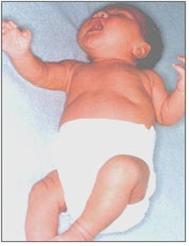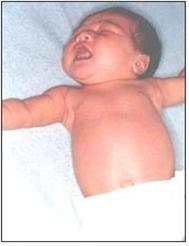모로 반사(포옹반사), Moro reflex
- 모로 반사가 갓 태어나서부터 생후 3∼4개월까지 정상적으로 나타날 수 있다.
- 모로 반사는 인간 생명유지 행동반사이고 원시 반사이다.
- 모로 반사를 포옹반사라고도 한다. 나는 만세 반사라고 부르고 싶다.
- 신생아나 영아의 얼굴, 앞가슴은 천정을 향해 위로, 뒷머리, 등 엉덩이는 바닥을 향해 눕혀 있은 상태에서 모로 검사를 다음과 같이 할 수 있다.
- 검사하는 사람의 한쪽 손바닥으로 아기의 후두부를 약간 위로 올려 받치고 있다가 아기 뒷머리를 받쳤던 손을 갑자기 머리에서 뗀다. 이때 아기의 머리가 바닥에 까지 떨어져 부딪치지 않게 바닥을 향해 아기머리를 갑자기 뚝 떨어지게 머리에 댔던 손바닥을 뗄 때 모로 반사가 생긴다.
- 아기는 좌우 상지를 맨 처음 몸통의 좌우 옆을 향해→머리 쪽 위로 향해 활짝 폈다가→곧 바로 활짝 폈던 양 팔을 몸통의 앞으로 가져오고→원래 있던 자세로 돌아오는 동작을 취한다.
- 마치 두 팔을 갑자기 번쩍 들고 만세를 하고 난 후 두 팔로 누구를 껴안으려하는 것 같은 자세를 취한다.
- 이런 일련의 자세를 갑자기 같은 움직임으로 취한다.
- 이 반사를 모로 반사, 포옹반사,”만세반사”라고 한다.
- 모로 반사가 나타날 때 양손과 모든 손가락들을 활짝 편다.
- 위에서 설명한 것같이 모로 반사가 나타날 때는 양 상지를 대칭적으로 움직이는 것이 보통이다.
- 모로 반사는 태어나서부터 생후 3∼4개월경까지 있다가 자연적으로 없어진다.
- 모로 반사는 0∼4개월 된 건강한 신생들이나 영아들에게 정상적으로 나타나는 정상적인 원시 반사이다.
- 모로 반사가 신생아들이나 영아들에게 나타날 때 부모들, 특히 초보 맘들은, 신생아나 영아가 무엇으로 놀래서 그런 자세를 취한다고 걱정하기도 한다.
- 때로는 쓸데없이 약물로 치료 한다.
- 모로 반사는 옷을 입힐 때도 신생아들에게 생길 수 있다.
- 갑자기 큰 소리로 자극 받을 때도 생길 수 있다.
- 신생아가 배를 바닥에 대고 누워 있을 때는 모로 반사가 거의 생기지 않는다.

사진 2-78. 영아에게 나타난 모로 반사 좌우 상지를 몸통의 양쪽 옆으로 향해 활짝 펴기 시작한다.
Copyright ⓒ 2012 John Sangwon Lee, MD., FAAP

사진 2-79. 모로 반사 좌우 상지를 몸통 양쪽 옆으로 향해 활짝 폈다. 이 영아는 영아산통으로 많이 운다. 많이 먹어서 배가 부른 것도 사진에서 볼 수 있다.
Copyright ⓒ 2012 John Sangwon Lee, MD., FAAP
표 신생아들이나 영아들에게 나타나는 원시 반사
|
처음 나타나는 나이와 없어지는 나이
원시 반사의 종류 |
처음 나타나는 나이 | 없어지는 나이 |
| 긴장성 경반사(목 긴장성 반사/긴장성 목 반사) Tonic neck reflex) | 임신 28주 태아 | 생후 7~8개월 |
| 모로 반사(포옹 반사/ 만 세 반사) Moro reflex) | 임신 20주 태아 | 생후 7~8개월 |
| 파악 반사(움켜잡기 반사) Grasp reflex | 임신 28주 태아 | 생후 2~3개월 |
| 몸통 굴곡 반사 (Trunk in -curve refex) | 임신 28주 태아 | 생후 3~4개월 |
| 돌 눈 반사 (Doll’s eye reflex) | 임신 32주 태아 | 생후 4~5개월 |
| 바빈스키 반사 (Babinski reflex) | 임신 38 주 태아 | 생후 10일 |
| 보행 반사 (Walking reflex) | – | 생후 12~16개월 |
| 플레이싱 반사(위치 반사) Placing reflex) | 출생 시 | – |
- 얼굴이 천장을 향하게 하고 등이 바닥에 대게 한 체위로 신생아나 영아를 눕힐 때 모로 반사가 더 잘 생긴다.
- 모로 반사가 신생아나 영아가 부모 품에서 떨어지기 싫다는 것을 부모에게 알려 주기 위해 나타나는 것 같다.
- 모로 반사가 나타날 때 아기를 바로 꼭 안아 주든지 담요로 꼭 싸서 잠자리에 눕히든지 아기의 손, 팔, 다리, 몸통을 포근히 잡아주면 모로 반사가 즉시 멈추는 것이 보통이다.
- 이런 모로 반사는 생후 3∼4개월경까지 나타나다가 그 이후부터 더 이상 나타나지 않는 것이 정상이다.
- 신생아나 영아에게 모로 반사나 긴장성 경반사가 나타날 때 아기가 놀래 그런 현상이 생긴다고 걱정하는 부모도 있다.
- 모로 반사는 몸 양쪽 대칭적으로 생기지만 그 한쪽 팔에만 모로 반사가 나타나면 한쪽 팔이나 어깨, 또는 쇄골 등에 골절이 있을 수 있다.
- 몸 양쪽 중 한쪽 신경 이상이 있나 알아봐야 한다.
- 모로 반사는 대칭적으로 나타나는 것이 정상이다.
Moro reflex
• Moro reflex may appear normally from birth to 3 to 4 months of age.
• The Moro reflex is a human life support behavioral reflex and a primitive reflex.
• The Moro reflex is also called the hug reflex. I like to call it the hurray reflex.
• You can perform the Moro test as follows with the face and chest of a newborn or infant lying on their back with the ceiling facing upward and the back of the head and hips facing the floor.
• Support the baby’s occipital area slightly upward with one hand of the examiner, then suddenly remove the hand supporting the baby’s back head. At this time, when the baby’s head falls to the floor and the baby’s head suddenly falls toward the floor so that it does not hit the floor, the moro reflex occurs when the palm that was placed on the head is released.
• The baby takes the action of first opening the left and right upper limbs toward the left and right sides of the body → toward the top of the head → bringing both arms straight out in front of the body → returning to the original position.
• Take a pose as if you were about to hug someone with your arms after suddenly raising your arms and hurrahing.
• A series of postures of this kind are suddenly taken with the same movement.
• This reflex is called the Moro reflex, the hug reflex, and the “Hurray reflex”.
• When the Moro reflex occurs, open both hands and all fingers wide.
• As described above, it is normal to move the upper limbs symmetrically when the Moro reflex occurs.
• Moro reflex is present from birth to around 3 to 4 months of age and then disappears naturally.
• The Moro reflex is a normal hyperopia reflex that is normally seen in healthy newborns and infants aged 0-4 months.
• When the Moro reflex occurs in newborns or infants, parents, especially novice mothers, may be concerned that the newborn or infant is frightened by something and assumes such a position.
• Sometimes it is unnecessary to treat with medication.
• The Moro reflex can also occur in newborns when dressed.
• It can also happen when you are suddenly stimulated by a loud sound.
• Little reflexes occur when a newborn is lying on her tummy on the floor.

Picture 2-78. The Moro reflex that appears in the infant begins to straighten the left and right upper limbs toward both sides of the body. Copyright ⓒ 2012 John Sangwon Lee, MD., FAAP

Picture 2-79. Moro reflex The left and right upper limbs were opened wide toward the sides of the body. This infant cries a lot for colic. You can see in the picture that I was full because I ate a lot. Copyright ⓒ 2012 John Sangwon Lee, MD., FAAP
Table Primitive Reflexes in Newborns and Infants age at first appearance age to disappear
표 신생아들이나 영아들에게 나타나는 원시 반사
|
Age at first appearance age to disappear
Types of Primitive Reflexes |
age of the first appearance | age to disappear |
| 긴장성 경반사(목 긴장성 반사/긴장성 목 반사) Tonic neck reflex | 28 weeks pregnant fetus | 7-8 months old |
| 모로 반사(포옹 반사/ 만 세 반사)
Moro reflex |
20 weeks pregnant fetus | 7~8 months old |
| 파악 반사(움켜잡기 반사)
Grasp reflex |
28 weeks pregnant fetus | 2~3months old |
| 몸통 굴곡 반사
Trunk in-curve refex |
28 weeks pregnant fetus | 3~4 months old |
| 돌 눈 반사
Doll’s eye reflex |
32 weeks pregnant fetus | 4~5 months old |
| 바빈스키 반사 Babinski reflex | 38 weeks pregnant fetus | 10 days old |
| 보행 반사
Walking reflex |
– | 12~16 months old |
| 플레이싱 반사(위치 반사)
Placing reflex |
at birth | – |
• Moro reflexes are better when the newborn or infant is placed in a position with the face facing the ceiling and the back on the floor.
• The Moro reflex appears to be present to inform parents that the newborn or infant does not want to be separated from the parent.
• When the Moro reflex appears, it is normal for the Moro reflex to stop immediately if you hug the baby tightly or put it on the bed tightly wrapped in a blanket, or hold the baby’s hands, arms, legs, and torso.
• It is normal for these Moro reflexes to appear until around 3 to 4 months of age and then no longer appear thereafter.
• When a newborn or infant develops the Moro reflex or the tonic neck reflex, some parents worry that the baby will be surprised.
• Moro reflex occurs symmetrically on both sides of the body, but if the Moro reflex appears only on one arm, there may be a fracture in one arm, shoulder, or clavicle.
• You should check for any nerve problems on one side of your body.
출처 및 참조 문헌 Sources and references
- NelsonTextbook of Pediatrics 22ND Ed
- The Harriet Lane Handbook 22ND Ed
- Growth and development of the children
- Red Book 32nd Ed 2021-2024
- Neonatal Resuscitation, American Academy Pediatrics
- www.drleepediatrics.com 제1권 소아청소년 응급 의료
- www.drleepediatrics.com 제2권 소아청소년 예방
- www.drleepediatrics.com 제3권 소아청소년 성장 발육 육아
- www.drleepediatrics.com 제4권 모유,모유수유, 이유
- www.drleepediatrics.com 제5권 인공영양, 우유, 이유식, 비타민, 미네랄, 단백질, 탄수화물, 지방
- www.drleepediatrics.com 제6권 신생아 성장 발육 육아 질병
- www.drleepediatrics.com제7권 소아청소년 감염병
- www.drleepediatrics.com제8권 소아청소년 호흡기 질환
- www.drleepediatrics.com제9권 소아청소년 소화기 질환
- www.drleepediatrics.com제10권. 소아청소년 신장 비뇨 생식기 질환
- www.drleepediatrics.com제11권. 소아청소년 심장 혈관계 질환
- www.drleepediatrics.com제12권. 소아청소년 신경 정신 질환, 행동 수면 문제
- www.drleepediatrics.com제13권. 소아청소년 혈액, 림프, 종양 질환
- www.drleepediatrics.com제14권. 소아청소년 내분비, 유전, 염색체, 대사, 희귀병
- www.drleepediatrics.com제15권. 소아청소년 알레르기, 자가 면역질환
- www.drleepediatrics.com제16권. 소아청소년 정형외과 질환
- www.drleepediatrics.com제17권. 소아청소년 피부 질환
- www.drleepediatrics.com제18권. 소아청소년 이비인후(귀 코 인두 후두) 질환
- www.drleepediatrics.com제19권. 소아청소년 안과 (눈)질환
- www.drleepediatrics.com 제20권 소아청소년 이 (치아)질환
- www.drleepediatrics.com 제21권 소아청소년 가정 학교 간호
- www.drleepediatrics.com 제22권 아들 딸 이렇게 사랑해 키우세요
- www.drleepediatrics.com 제23권 사춘기 아이들의 성장 발육 질병
- www.drleepediatrics.com 제24권 소아청소년 성교육
- www.drleepediatrics.com 제25권 임신, 분만, 출산, 신생아 돌보기
- Red book 29th-31st edition 2021
- Nelson Text Book of Pediatrics 19th- 21st Edition
- The Johns Hopkins Hospital, The Harriet Lane Handbook, 22nd edition
- 응급환자관리 정담미디어
-
소아가정간호백과–부모도 반의사가 되어야 한다, 이상원
-
Neonatal Resuscitation American heart Association
-
Neonatology Jeffrey J.Pomerance, C. Joan Richardson
-
Pediatric Resuscitation Pediatric Clinics of North America, Stephen M. Schexnayder, M.D.
-
Pediatric Critical Care, Pediatric Clinics of North America, James P. Orlowski, M.D.
-
Preparation for Birth. Beverly Savage and Dianna Smith
-
Infectious disease of children, Saul Krugman, Samuel L Katz, Ann A. Gershon, Catherine Wilfert
- 소아과학 대한교과서
- Other
Copyright ⓒ 2015 John Sangwon Lee, MD., FAAP
“부모도 반의사가 되어야 한다”-내용은 여러분들의 의사로부터 얻은 정보와 진료를 대신할 수 없습니다.
“The information contained in this publication should not be used as a substitute for the medical care and advice of your doctor. There may be variations in treatment that your doctor may recommend based on individual facts and circumstances. “Parental education is the best medicine.”